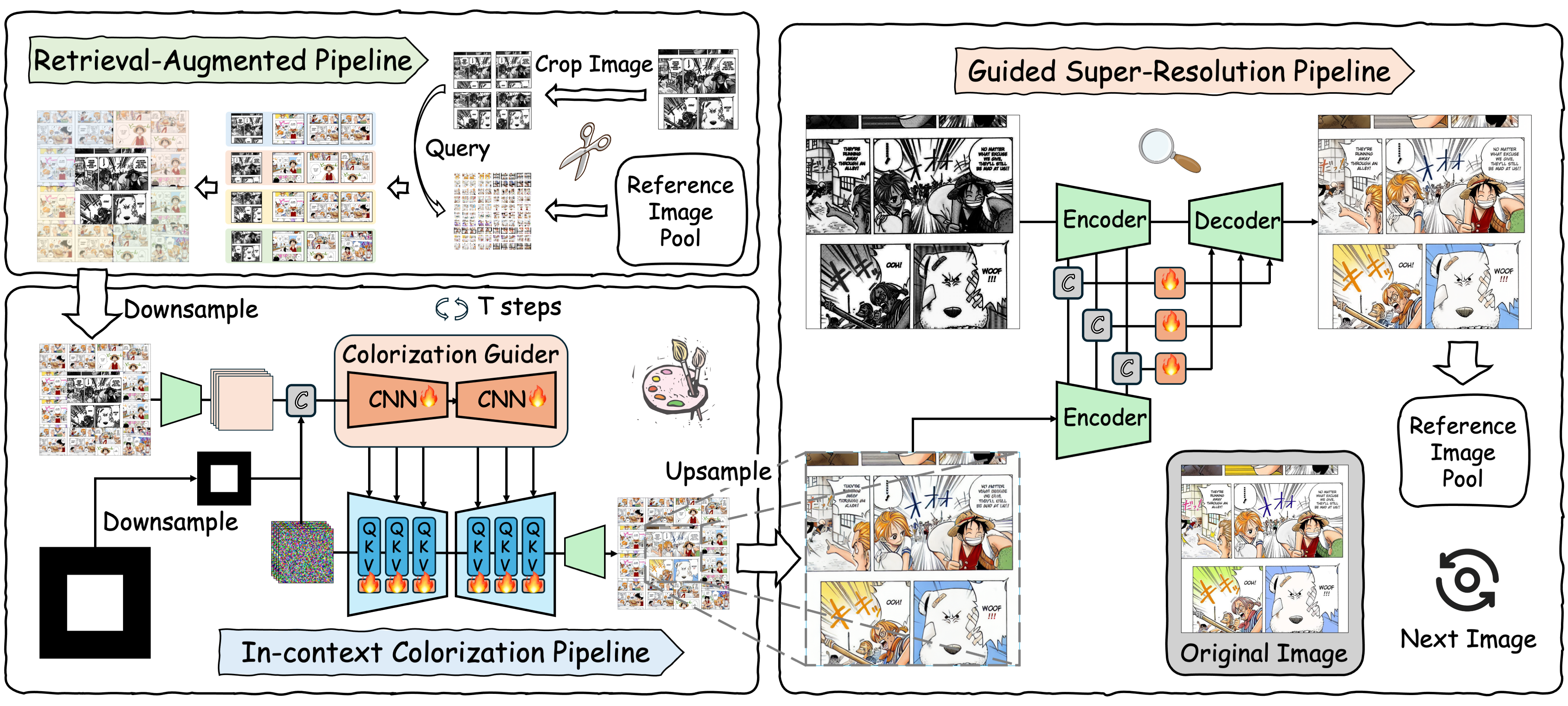Retrieval-Augmented Image Sequence Colorization
Authors: Junhao Zhuang, Xuan Ju, Zhaoyang Zhang, Yong Liu, Shiyi Zhang, Chun Yuan, Ying Shan
Your star means a lot for us to develop this project! ⭐
This README provides a guide on how to prepare a manga dataset and use the ColorFlow tool for processing.
Before you begin, ensure you have the following installed:
- Python 3.x
- Git
- FFmpeg
- Obtain Manga Images:
- Visit the Genshin Impact manga website to download or view manga images.
- Example links:
### zh-tw
# https://sg-public-api-static.hoyoverse.com/content_v2_user/app/a1b1f9d3315447cc/getContentList?iAppId=32&iChanId=401&iPageSize=1000&iPage=1&sLangKey=zh-tw
### en-us
# https://sg-public-api-static.hoyoverse.com/content_v2_user/app/a1b1f9d3315447cc/getContentList?iAppId=32&iChanId=401&iPageSize=1000&iPage=1&sLangKey=en-us
import requests
import json
# 目标 URL
url = "https://sg-public-api-static.hoyoverse.com/content_v2_user/app/a1b1f9d3315447cc/getContentList?iAppId=32&iChanId=401&iPageSize=1000&iPage=1&sLangKey=en-us"
# 发送 GET 请求
response = requests.get(url)
# 检查请求是否成功
if response.status_code == 200:
# 解析 JSON 数据
data = response.json()
# 指定保存的文件路径
file_path = "genshin_impact_manga.json"
# 将数据写入到 .json 文件
with open(file_path, 'w', encoding='utf-8') as json_file:
json.dump(data, json_file, ensure_ascii=False, indent=4)
print(f"数据已成功保存到 {file_path}")
else:
print(f"请求失败,状态码: {response.status_code}")
import json
import pandas as pd
import numpy as np
with open("genshin_impact_manga.json", "r", encoding="utf-8") as f:
j_obj = json.load(f)
df = pd.DataFrame(j_obj["data"]["list"])
dff = df[["sTitle", "sIntro", "sExt"]]
dff["sExt"] = dff["sExt"].map(eval)
dff["sExt_401_0"] = dff["sExt"].map(lambda x: x["401_0"])
dff["sExt_401_1"] = dff["sExt"].map(lambda x: x["401_1"])
dff = dff.iloc[::-1, :]
dfff = dff.iloc[:, [0, 1, 3]].explode("sExt_401_0")
dfff["name"] = dfff["sExt_401_0"].map(lambda x: x["name"])
dfff["url"] = dfff["sExt_401_0"].map(lambda x: x["url"])
dfff = dfff.iloc[:, [0, 1, 3, 4]].reset_index().iloc[:, 1:]
dfff
import requests
from PIL import Image
from io import BytesIO
def url_to_image(url):
# 发送HTTP GET请求获取图像数据
response = requests.get(url)
response.raise_for_status() # 如果请求失败,抛出异常
# 将获取到的图像数据转换为PIL图像对象
image = Image.open(BytesIO(response.content))
return image
from datasets import Dataset
ds = Dataset.from_pandas(dfff.reset_index().iloc[:, 1:])
dss = ds.map(
lambda x: {"image": url_to_image(x["url"])}, num_proc = 4
)
dss.save_to_disk("im_local")
#dss.push_to_hub("svjack/Genshin-Impact-Manga")
dss.push_to_hub("svjack/Genshin-Impact-Manga-EN-US")
#https://huggingface.co/spaces/ragavsachdeva/Magiv2-Demo
#https://huggingface.co/spaces/ragavsachdeva/the-manga-whisperer
#https://github.com/ragavsachdeva/magi- Prepare Reference Image:
- Ensure you have at least one image with two characters for reference. This image will be used for colorization or other processing tasks.
-
Update and Install Dependencies:
sudo apt-get update && sudo apt-get install cbm ffmpeg -
Clone the ColorFlow Repository:
git clone https://huggingface.co/spaces/svjack/ColorFlow && cd ColorFlow
-
Install Python Requirements:
pip install -r requirements.txt
- Start the Application:
python app.py
- API Method
### 使用api 方法
from gradio_client import Client, handle_file
from PIL import Image
import pandas as pd
#client = Client("https://a9b5f5cb5cf97de36e.gradio.live/")
client = Client("http://127.0.0.1:7860")
result = client.predict(
query_image_=handle_file('nlu.png'),
input_style="Sketch",
resolution="640x640",
api_name="/extract_line_image"
)
print(result)
final_result = client.predict(
reference_images=[handle_file("nlutree.jpg")],
resolution="640x640",
seed=0,
input_style="Sketch",
num_inference_steps=30,
api_name="/colorize_image"
)
print(final_result)
Image.open(pd.DataFrame(final_result)["image"][0])
Image.open(pd.DataFrame(final_result)["image"][2])
result = client.predict(
query_image_=handle_file('nlu.png'),
input_style="GrayImage(ScreenStyle)",
resolution="640x640",
api_name="/extract_line_image"
)
print(result)
final_result = client.predict(
reference_images=[handle_file("nlutree.jpg")],
resolution="640x640",
seed=0,
input_style="GrayImage(ScreenStyle)",
num_inference_steps=30,
api_name="/colorize_image"
)
print(final_result)
Image.open(pd.DataFrame(final_result)["image"][0])
Image.open(pd.DataFrame(final_result)["image"][2])
#### sketch 会亮和鲜艳一些
#### https://github.com/TencentARC/ColorFlow/issues/3Automatic black-and-white image sequence colorization while preserving character and object identity (ID) is a complex task with significant market demand, such as in cartoon or comic series colorization. Despite advancements in visual colorization using large-scale generative models like diffusion models, challenges with controllability and identity consistency persist, making current solutions unsuitable for industrial application.
To address this, we propose ColorFlow, a three-stage diffusion-based framework tailored for image sequence colorization in industrial applications. Unlike existing methods that require per-ID finetuning or explicit ID embedding extraction, we propose a novel robust and generalizable Retrieval Augmented Colorization pipeline for colorizing images with relevant color references.
Our pipeline also features a dual-branch design: one branch for color identity extraction and the other for colorization, leveraging the strengths of diffusion models. We utilize the self-attention mechanism in diffusion models for strong in-context learning and color identity matching.
To evaluate our model, we introduce ColorFlow-Bench, a comprehensive benchmark for reference-based colorization. Results show that ColorFlow outperforms existing models across multiple metrics, setting a new standard in sequential image colorization and potentially benefiting the art industry.
- Release Date: 2024.12.17 - Inference code and model weights have been released! 🎉
- ✅ Release inference code and model weights
- ⬜️ Release training code
Follow these steps to set up and run ColorFlow on your local machine:
-
Clone the Repository
Download the code from our GitHub repository:
git clone https://github.com/TencentARC/ColorFlow cd ColorFlow -
Set Up the Python Environment
Ensure you have Anaconda or Miniconda installed, then create and activate a Python environment and install required dependencies:
conda create -n colorflow python=3.8.5 conda activate colorflow pip install -r requirements.txt
-
Run the Application
You can launch the Gradio interface for PowerPaint by running the following command:
python app.py
-
Access ColorFlow in Your Browser
Open your browser and go to
http://localhost:7860. If you're running the app on a remote server, replacelocalhostwith your server's IP address or domain name. To use a custom port, update theserver_portparameter in thedemo.launch()function of app.py.
You can try the demo of ColorFlow on Hugging Face Space.
The overview of ColorFlow. This figure presents the three primary components of our framework: the Retrieval-Augmented Pipeline (RAP), the In-context Colorization Pipeline (ICP), and the Guided Super-Resolution Pipeline (GSRP). Each component is essential for maintaining the color identity of instances across black-and-white image sequences while ensuring high-quality colorization.
🤗 We welcome your feedback, questions, or collaboration opportunities. Thank you for trying ColorFlow!
We would like to acknowledge the following open-source projects that have inspired and contributed to the development of ColorFlow:
- ScreenStyle: https://github.com/msxie92/ScreenStyle
- MangaLineExtraction_PyTorch: https://github.com/ljsabc/MangaLineExtraction_PyTorch
We are grateful for the valuable resources and insights provided by these projects.
- Junhao Zhuang
Email: zhuangjh23@mails.tsinghua.edu.cn
@misc{zhuang2024colorflow,
title={ColorFlow: Retrieval-Augmented Image Sequence Colorization},
author={Junhao Zhuang and Xuan Ju and Zhaoyang Zhang and Yong Liu and Shiyi Zhang and Chun Yuan and Ying Shan},
year={2024},
eprint={2412.11815},
archivePrefix={arXiv},
primaryClass={cs.CV},
url={https://arxiv.org/abs/2412.11815},
}
Please refer to our license file for more details.









